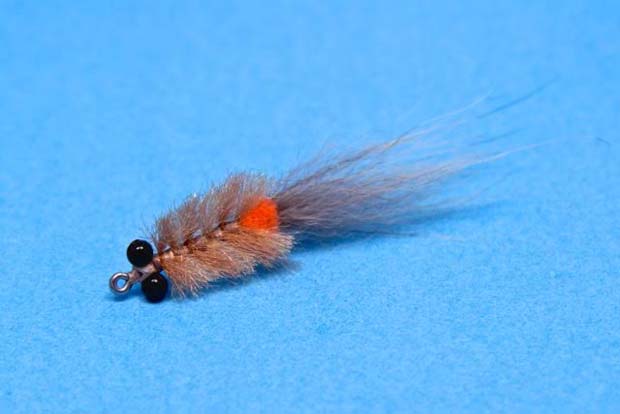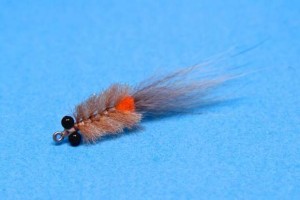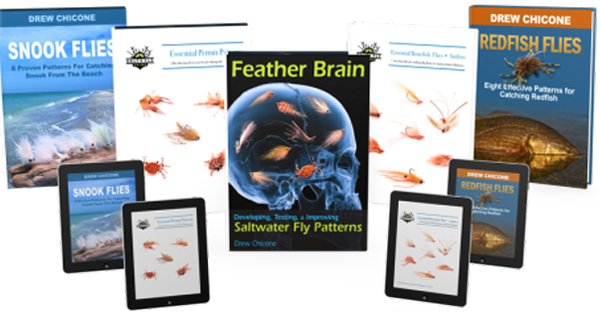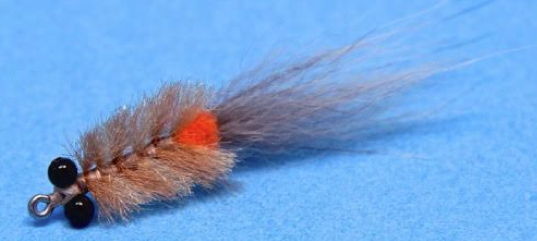Patrick Dorsey’s classic Kwan fly background
By Drew Chicone
[dropcap]P[/dropcap]atrick Dorsey’s classic Kwan pattern is without a doubt one of the most effective saltwater utility patterns of all time. Often refered to as the “Grand Slam Fly,” it has proven deadly on bonefish and permit in smaller sizes
and is one of my favorites for back bay snook, redfish, and tarpon when tied on a beefier hook. Stiffer deer hair was tied-in beneath a barred craft fur tail on the original pattern, and in the later the addition a mono loop was used to keep the wispy synthetic fiber from fouling.
Alternating brown and tan rug yarn was figure-eighted to the hook shank to create a fat oval body. This is a near perfect combination of materials on larger sized hooks like 1’s 2’s and even 4’s but as you creep down the size chart, I have found that a few adjustments and or material substitutions make a big difference to the appearance and performance of the fly in the water.
EP Fibers in place of the rug yarn
First and for most, I like to use EP Fibers in place of the rug yarn. It is much easier to find, and is available in a seemingly endless array of colors to choose from. For smaller flies tied on size 6’s, and 8’s less material is required, and the EP Fiber is much thinner and easier to work with.
Craft fur tail not scalable for the smaller sizes
The same goes for the craft fur tail. This is a wonderful material for larger flies, but It’s just not scalable for the smaller sizes. The vast majority of what you find today in your local fly shop is “extra select” Craft Fur, which has much longer fibers. Even if you pull out the longer fibers in an attempt to create a shorter tapered bundle to tie in for the tail, much of the material is wasted. And after you pick out the underfur from the butts of the material, there just isn’t much left to work with.
Arctic Fox and Finnish Raccoon
At first I experimented with Arctic Fox and Finnish Raccoon, and their soft fibers really move wonderfully in the water. Unfortunately the same characteristics that give it a life like look, also causes it to foul constantly. The answer to this conundrum… Coyote. This canine is quickly becoming one of my favorite bonefish materials. Not only it slightly stiffer than the previously listed options so it doesn’t foul as easily, but it is also multi colored. The natural tans, grays, browns and blacks give it an extremely natural look, and it’s fibers are plenty long for just about any sized flats fly you want to tie.
Yes, hook point down!
The McFly foam egg sac was brought to the table for a couple of reasons. Not only does a slight pop of orange almost always improve your chances on the bonefish flat, it also helps to keep the EP Fibers splayed, and the hook riding point down.
The Dorsey Kwan Fly Recipe:
Materials
Hook: Diiachi 2546 or Similar Saltwater Hook
Thread: Tan UTC Ultra 140
Eyes: Medium Stainless or Black Bead Chain
Body: Tan and Bronze EP Fiber
Egg Sack: Orange McFly Foam
Tail: Coyote Tail Fur
Adhesive: Clear Cure Goo Hydro
The Dorsey Kwan Fly Tying Instructions. All photos by Drew Chicone:
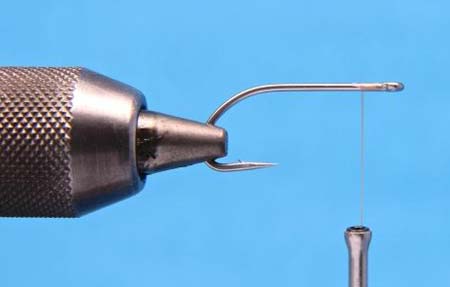
Step 1:
Start the thread at the eye of the hook and wrap back 10 turns — 15 turns if you want to add a weed guard.

Step 2:
With a series of snug figure eight wraps, tie in the bead chain eyes. Cut a matchstick sized hank of Coyote Fur, comb out the under fur, trim the butt’s even and tie in directly behind the eyes. Continue wrapping backward covering the fur with a series of evenly stacked wraps until you reach the bend of the hook.

Step 3:
Tie in a single section of orange McFly Foam at it’s middle, and trim at approximately 1/4-inch.

Step 4:
On the near side of the hook, tie in a sparse piece of Tan EP Fiber. Leave about 1/2″ on the right side of the tie in point so that you can fold it over the top of the hook shank.

Step 7:
Repeat the same process as you did for the Tan EP Fiber in Step 5. and advance your thread in front of the material bump.
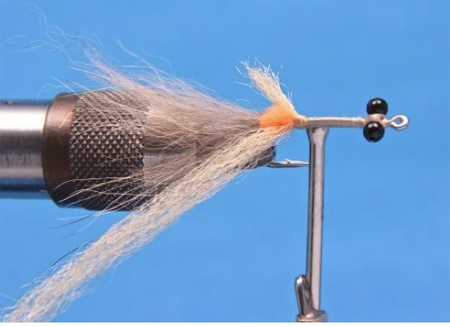
Step 5:
Pull the 1/2″ section of the Tan EP Fiber over the top of the hook and make 7-8 wraps on top of the folded material to secure in place. Advance your thread in from the but bump of material. This technique is much cleaner and easier compared to figure eight wrapping tiny sections of fiber in place. Leave the excess material in place and do not trim.
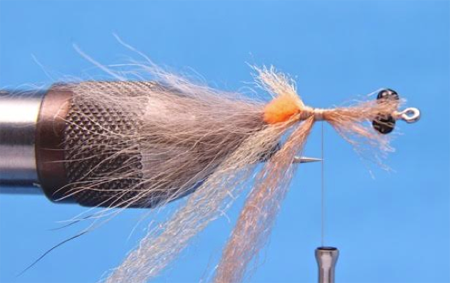
Step 6:
Directly in front of the Tan section, tie in a second section of Bronze EP Fiber leaving about 1/2″ inch of material to the left of the tie in point as you did before.

Step 7:
Repeat the same process as you did for the Tan EP Fiber in Step 5. and advance your thread in front of the material bump.
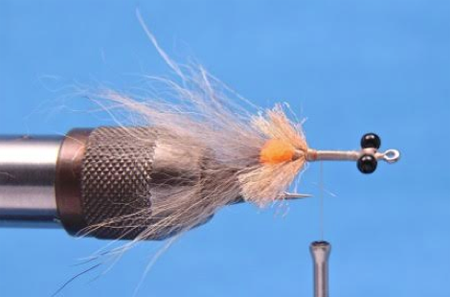
Step 8:
Keeping the two colors separated between different fingers, grab both pieces of the EP Fiber, and trim to 1/2″. By cutting both pieces at the same time, you reduce the chance of trimming one section too short and you increase your tying speed… which really helps when you are tying dozens at a time!
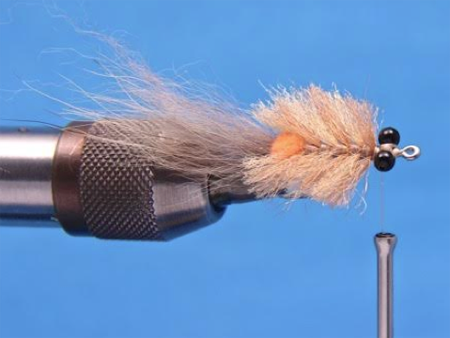
Step 9:
Continue the process, alternating the colors as you go and trimming after each pair until you reach the bead chain eyes. Whip finish behind the eyes and cut away the thread.
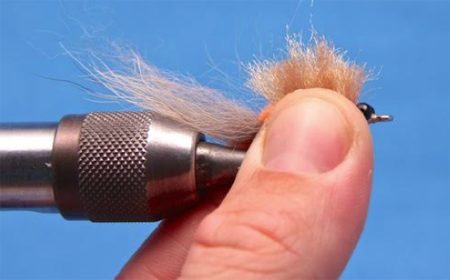
Step 10:
Using your index finger and thumb, pinch all the EP Fibers and pull them up away from the tail and hook shank.

Step 11:
Use your fingers as a template and trim the EP Fibers to a crescent shape approximately 1/4″ from the hook shank.


